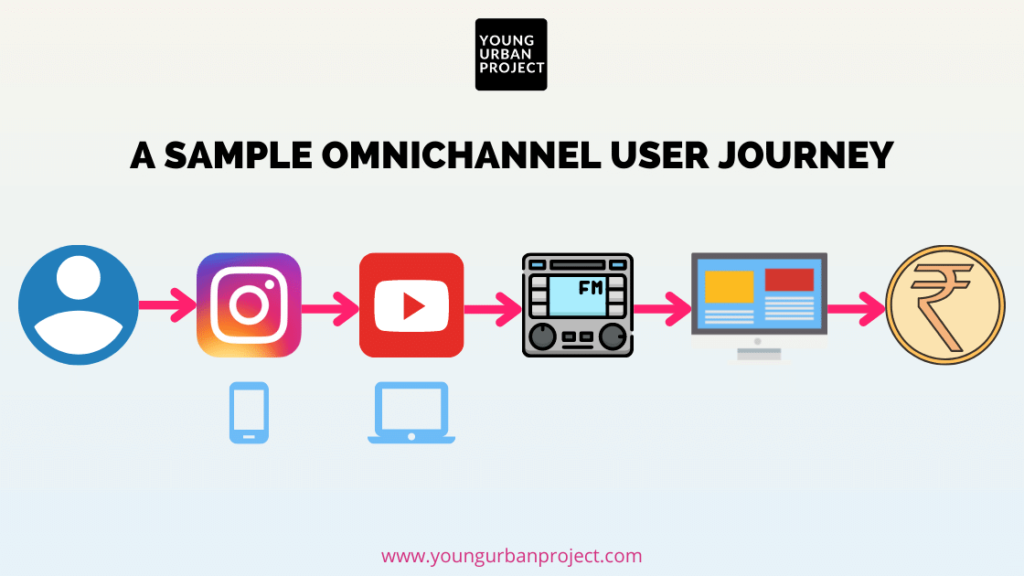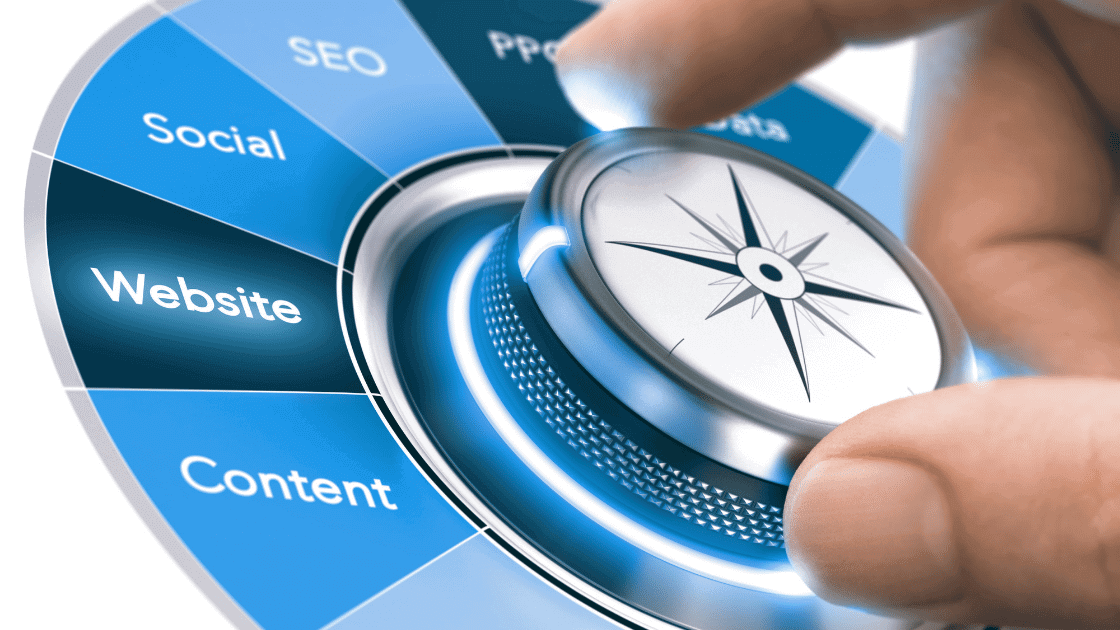The world of marketing has witnessed a lot of advancement and rapid evolution in the past decade.
With this shift, users are spending more time than ever on digital platforms and every marketer must learn digital marketing. But there is still a substantial chunk of their time being spent consuming traditional media too.
When making purchase decisions, users go through a journey from awareness to conversion (called Customer Journey). And this journey doesn’t take place on a single device or a single social media channel.
Let’s take an example:
- A user discovers a brand on Instagram through a viral reel.
- And then they eventually see the brand’s ads on Youtube mobile.
- Then, the user later hears the brand’s ad on the Car Radio.
- And they decide to visit the brand’s website on their laptop when they reach the workplace.
- And then they finally complete the purchase.

This shows how a user traverses across devices and platforms to make a purchase.
As a result, all businesses have to leverage multiple channels simultaneously to reach their potential customers.
This multi-channel presence (and marketing) is termed Omnichannel Marketing.
Table of Contents
What is Omnichannel Marketing?
In the evolving world of marketing, businesses cannot afford to choose just a single channel for acquisition and branding.
In the last few years, many businesses have started focusing on creating their presence across multiple (or all) channels.
In simple words, Omnichannel marketing refers to using all online (website, app, social media, email, SMS, WhatsApp) and offline (retail stores, events, call centers) channels to create a brand presence among customers.
This type of marketing specifically focuses on providing a positive and seamless experience to the users throughout the customer journey on all channels.
Disneyland’s marketing is a great example of Omnichannel Marketing.
It starts with the initial experience on the mobile responsive site and continues with its trip planning on mobile.
And once you have booked the trip, you can use the My Disney Experience tool to help plan your trip. You can use an app on your mobile to find attractions within the park and even the estimated waiting time for each attraction. Thus creating a superb Omnichannel experience.
Benefits of Omnichannel Marketing
Omnichannel marketing may sound very complicated to you when you first hear about it. It’s a valid thought, how can any business focus on so many channels at the same time?
Marketing a business through multiple channels can be overwhelming and might stretch the bandwidth.
However, the advantages of Omnichannel marketing outweigh the effort that goes in.
Here are some of the benefits of Omnichannel marketing:
1. Consistent Brand Strategy & Identity
Creating a seamless strategy across channels means building an easily identifiable brand image and tone.
While focusing on the overall experience and ensuring you follow your brand guidelines while working on each channel, you will have a more comprehensive brand strategy.
This will help increase customer loyalty and help with better-targeted messaging.
2. Increased Revenue
Through an omnichannel approach, customers get to engage with your brand across multiple touchpoints and channels.
Due to these increased and diverse engagements, you end up increasing your revenue at each stage of the buyer’s journey.
According to studies, customers that engage with multiple touchpoints are 30 percent more valuable.
This helps builds loyalty, increasing the probability that a customer will purchase from your brand again.
Repeat customers can contribute to 40% of your revenue if an omnichannel strategy is optimally used.
3. Better Attribution Data
By adopting an omnichannel strategy you enhance the user’s experience with your brand, and also strengthen your data analytics.
By tracking customer behavior across channels, you can get a better understanding of what your customer’s journey looks like.
You get an insight into when and where consumers prefer to engage, and which campaigns have performed better than the others.
All this data helps you refine your strategy to build more targeted campaigns and optimize your spending.
Omnichannel vs Multichannel Marketing: What’s the Difference?
Now that you’ve understood what omnichannel marketing is, it’s important to understand how it is different from something called “Multichannel Marketing”.
Here’s the primary difference:
Multichannel marketing gives your customers access to different platforms, but they are not necessarily synchronized.
On the other hand, Omnichannel marketing gives them access to different platforms that are inter-connected.
For example, If you want to have a coffee, traditionally you would go to a coffee shop and order coffee. Maybe opt for takeaway. While this coffee shop might be present on Instagram or Twitter but this presence doesn’t directly affect your purchase.
On the other hand, Starbucks lets you pre-order via an app, so you can just enter the Starbucks outlet, collect your order and leave.
Thus making ordering and payment easier for the customer. Starbucks could boost its revenue through omnichannel technology.
How to create a perfect Omnichannel experience?
Creating the perfect omnichannel experience can be an overwhelming task for marketers, but with the right focus, it can be achieved.
You need to begin by understanding your customers deeply. As easy as it seems, it requires proper research starting by creating a Buyer Persona.
Understanding your customer base means closely observing the kind of platforms your customers use most frequently.
This also includes examining their purchasing behavior, the challenges that they face, what are their pain points, what is their goal in life to list a few points.
With this data, you can easily identify the right touch-points and focus on strengthening them.
Connecting these touchpoints will create a seamless and tailor-made experience for your customers.
Omni-channel marketing campaign guide
Omnichannel marketing requires you to focus on each channel equally and build a consistent flow of work.
To build an Omni-channel marketing campaign, it is crucial to work on all channels consistently along with focusing on customer satisfaction.
1. Start with focusing on the Website and Social Media
First things first focus on the basics. When you’re initially starting with digital marketing, you need to put your foremost focus on building basic channels like your business website and social media channels.
Creating an Omnichannel is a slow process and you don’t need to start everything at once. Focus your efforts on major 2-3 channels and nail them with your marketing strategies. After that, gradually move towards the other platforms.
If you get on all the channels at once, you’ll end up neglecting the consistency of some channels and that would create a bad image of your brand.
Remember, customers, notice everything. Consistently post and engage on the initial channels and create an unbreakable presence of your brand before moving to other platforms.
- 2. Provide your services through an App
If your business deals with consumer products or offers SaaS services, this step is specifically for you.
You can evaluate having an app to offer your services to your customers.
Although having an app isn’t mandatory, an app can give a superior user experience that is completely native in nature.
If an app is not something that your business requires, you can achieve the same using a mobile responsive website or a PWA (Progressive Web App).
3. Follow a customer-centric approach
Omnichannel marketing requires you to have a customer-centric approach. This simply means that you have to assist your customers at every stage of their customer journey.
A customer-centric approach will not only give you more visibility but will also build a reputed brand image among your customers.
When your customers are happy with how your deal with their problems, you’ll see them coming back to your business.
4. Identify the right context
Sending the wrong message to the wrong audience at the wrong time is a waste of your marketing budget.
This might happen to you when you haven’t clearly understood the context of your Omnichannel marketing.
The best way to get the context right is to research thoroughly about your customers.
Focus on three things to get your customers engaging with your brand.
- The message is delivered to the users who’ll find it most relevant.
- It is sent at the right time i.e. when the users are most active
- It is sent on the channel where they are most active.
5. Create your marketing strategies based on Data
Data are a powerful tool that can help you win your customers.
With the help of CRM data, social listening data, and customers’ online search behavior, you can identify the interests and challenges of your customers.
Accordingly, you can create strategies to offer solutions for their challenges.
It is a great way to attract customers to your business.
6. Give your customers a personalized experience
Even though you’re dealing with a large amount of audience on all the channels, it is still important to personalize the customer journey of each one of them.
Here’s the best way to do this- Analyze the data you’ve collected of your customers and segment them into different categories based on their common behavior.
With this, you can easily recognize each category of your customer is interested in, in turn creating a personalized journey for each type of customer.
7. Include Calls-To-Action
People need to be told what to do.
Every time you engage with your customers on multiple channels, always include a Call-To-Action they can click or tap on.
This CTA must be device and platform appropriate.
However, it is important to ensure that your CTA doesn’t break your customer’s seamless experience that you’ve been providing them consistently.
Omnichannel marketing can provide a great customer experience because the channels are connected and they work together for one purpose.
Omnichannel customer experience is no longer an option.
All businesses have to rethink their customer journeys and find new ways to acquire, engage, and retain customers through positive experiences across multiple touch points.

